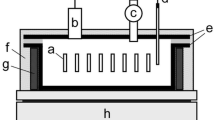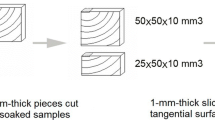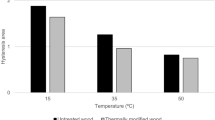Abstract
Sitka spruce wood specimens were heated at 120–140 °C and different relative humidity values (RHh), and their specific dynamic Young’s moduli (E′/ρ), mechanical loss tangents (tanδ), and CIELAB color parameters were measured at 25 °C and 60% relative humidity before and after the removal of water-soluble extractives. The E′/ρ and tanδ values were significantly decreased and increased, respectively, with increases in mass loss by heating at 100% RHh. After the removal of water-soluble extractives, the decreased E′/ρ was increased and the increased tanδ was decreased. This suggested that water-soluble sugars, i.e., depolymerization products of hemicelluloses, acted as plasticizers to decrease E′/ρ and increase tanδ values of hygrothermally treated wood, particularly for wood heated in humid conditions. By heating at 60–75% RHh, the E′/ρ was slightly increased and tanδ was almost unchanged. The water-soluble extractives had little effect on the color of the hygrothermally treated wood, irrespective of RHh.








Similar content being viewed by others
References
Altgen M, Hofmann T, Militz H (2016) Wood moisture content during the thermal modification process affects the improvement in hygroscopicity of Scots pine sapwood. Wood Sci Technol 50:1181–1195
Bekhta P, Niemz P (2003) Effect of high temperature on the change in color, dimensional stability and mechanical properties of spruce wood. Holzforschung 57:539–546
Bhuiyan MTR, Hirai N, Sobue N (2000) Changes of crystallinity in wood cellulose by heat treatment under dried and moist conditions. J Wood Sci 46:431–436
Borrega M, Kärenlampi PP (2008) Mechanical behavior of heat-treated spruce (Picea abies) wood at constant moisture content and ambient humidity. Holz Roh Werkst 66:63–69
Borrega M, Kärenlampi PP (2010) Hygroscopicity of heat-treated Norway spruce (Picea abies) wood. Eur J Wood Prod 68:233–235
Čermák P, Rautkari L, Horáček P, Saake B, Rademacher P, Sablík P (2015) Analysis of dimensional stability of thermally modified wood affected by re-wetting cycles. BioResources 10(2):3242–3253
Dwianto W, Tanaka F, Inoue M, Norimoto M (1996) Crystallinity changes of wood by heat or steam treatment. Wood Res 83:47–49
Endo K, Obataya E, Zeniya N, Matsuo M (2016) Effects of heating humidity on the physical properties of hydrothermally treated spruce wood. Wood Sci Technol 50:1161–1179
Hill CAS (2006) Thermal modification of wood. In: Wood modification: chemical, thermal and other processes. Wiley, Chichester, pp 99–127 (Chapter 5)
Hillis WE (1975) High temperature and chemical effects on wood stability. Part 1. General considerations. Wood Sci Technol 18:281–293
Hirashima Y, Sugihara M, Sasaki Y, Ando K, Yamasaki M (2004) Strength properties of aged wood, I: tensile strength properties of aged Keyaki and Akamatsu woods. Mokuzai Gakkaishi 50:301–309
Hirashima Y, Sugihara M, Sasaki Y, Ando K, Yamasaki M (2005) Strength properties of aged wood III, static and impact bending strength properties of aged Keyaki and Akamatsu woods. Mokuzai Gakkaishi 51:146–152
Kubojima Y, Okano T, Ohta M (1998) Vibrational properties of Sitka spruce heat-treated in nitrogen gas. J Wood Sci 44:73–77
Kubojima Y, Okano T, Ohta M (2000) Vibrational properties of heat-treated green wood. J Wood Sci 46:63–67
Matsuo M, Yokoyama M, Umemura K, Sugiyama J, Kawai S, Gril J, Kubodera S, Mitsutani T, Ozaki H, Sakamoto M, Imamura M (2011) Ageing of wood: analysis of color changes during natural ageing and heat treatment. Holzforschung 65:361–368
Millett MA, Gerhards CC (1972) Accelerated ageing: residual weight and flexural properties of wood heated in air at 115 to 175 °C. Wood Sci 4:193–201
Obataya E, Norimoto M (1995) The water sorption isotherms of cane (Arundo donax L.) used for reeds of woodwind instruments. Mokuzai Gakkaishi 41:1079–1085
Obataya E, Norimoto M (1999) Acoustic properties of a reed (Arundo donax L.) used for the vibrating plate of a clarinet. J Acoust Soc Am 106:1106–1110
Obataya E, Tomita B (2002) Hygroscopicity of heat-treated wood. II. Reversible and irreversible reductions in the hygroscopicity of wood due to heating. Mokuzai Gakkaishi 48:288–295
Obataya E, Gril J, Norimoto M (1998) The effects of adsorbed water on dynamic mechanical properties of wood. Polymer 39:3059–3064
Obataya E, Umezawa T, Nakatsubo F, Norimoto M (1999) The effects of water soluble extractives on the acoustic properties of reed (Arundo donax L.). Holzforschung 53:63–67
Obataya E, Ono T, Norimoto M (2000) Vibrational properties of wood along the grain. J Mater Sci 35(2993–3001):6317
Obataya E, Norimoto M, Tomita B (2001a) Mechanical relaxation processes of wood in the low-temperature range. J Appl Polym Sci 81:3338–3347
Obataya E, Minato K, Tomita B (2001b) Influence of moisture content on the vibrational properties of hematoxylin-impregnated wood. J Wood Sci 47:317–321
Obataya E, Higashihara T, Tomita B (2002) Hygroscopicity of heat-treated wood. III. Effects of steaming on the hygroscopicity of wood. Mokuzai Gakkaishi 48:348–355
Obataya E, Shibutani S, Hanata K, Doi S (2006) Effects of high temperature kiln drying on the practical performance of Japanese cedar wood (Cryptomeria japonica). II: changes in mechanical properties due to heating. J Wood Sci 52:111–114
Ono T (1996) Frequency responses of wood for musical instruments in relation to the vibrational properties. J Acoust Soc Jpn (E) 17:183–193
Sandberg D, Haller P, Navi P (2013) Thermo-hydro and thermo-hydro-mechanical wood processing: an opportunity for future environmentally friendly wood products. Wood Mater Sci Eng 8:64–88
Smith DS, Mannheim CH, Gilbert SG (1981) Water sorption isotherms of sucrose and glucose by inverse gas chromatography. J Food Sci 46:1051–1053
Stamm AJ (1956) Dimensional stabilization of wood with carbowaxes. Forest Prod J 6:201–204
Tanifuji K, Takahashi S, Kajiyama M, Ohi H, Nakamata K (2011) Advantage of acid sulfite cooking as process of bioethanol production. Jpn TAPPI J 65:494–505
Tjeerdsma BF, Militz H (2005) Chemical changes in hydrothermal treated wood: FTIR analysis of combined hydrothermal and dry heat-treated wood. Holz Roh Werkst 63:102–111
Tjeerdsma BF, Boonstra M, Pizzi A, Takely P, Militz H (1998) Characterization of thermally modified wood: molecular reasons for wood performance improvement. Holz Roh Werkst 56:149–153
Wentzel M, Altgen M, Militz H (2018) Analyzing reversible changes in hygroscopicity of thermally modified eucalypt wood from open and closed reactor systems. Wood Sci Technol 52(4):889–907. https://doi.org/10.1007/s00226-018-1012-3
Wikberg H, Maunu SL (2004) Characterisation of thermally modified hard- and softwoods by 13C CPMAS NMR. Carbohydr Polym 58:461–466
Yano H, Matsuhisa H (1991) Study on the timber of wood II, analysis of the sound spectrum of wood using viscoelastic Timoshenko equation. Sci Rep Kyoto Prefect Univ 43:24–31
Yin Y, Berglund L, Salmén L (2011) Effect of steam treatment on the properties of wood cell walls. Biomacromolecules 12:194–202
Yokoyama M, Gril J, Matsuo M, Yano H, Sugiyama J, Clair B, Kubodera S, Mitsutani T, Sakamoto M, Ozaki H, Imamura M, Kawai S (2009) Mechanical characteristics of aged Hinoki wood from Japanese historical buildings. C R Phys 10:601–611
Author information
Authors and Affiliations
Corresponding author
Additional information
Publisher's Note
Springer Nature remains neutral with regard to jurisdictional claims in published maps and institutional affiliations.
Rights and permissions
About this article
Cite this article
Zeniya, N., Endo-Ujiie, K., Obataya, E. et al. Effects of water-soluble extractives on the vibrational properties and color of hygrothermally treated spruce wood. Wood Sci Technol 53, 151–164 (2019). https://doi.org/10.1007/s00226-018-1069-z
Received:
Published:
Issue Date:
DOI: https://doi.org/10.1007/s00226-018-1069-z




